BACKGROUND:
Water is our most common natural resource.
It is essential to the biology and chemistry of all living things, it plays
a major role in shaping the earth and is an active agent in many physical
reactions. It is important to most life to keep it clean.
There is plenty of water on Earth, but 97%
of this water is saline (contains dissolved salts). Only 3% is fresh
and about two thirds of that amount is locked up in polar ice caps and
glaciers; about one third can be found as ground water, lakes, and in the
atmosphere.
Water exists in three states of matter:
solid (ice), liquid (water), and gas (vapor) at normal conditions.
Water is a colorless, odorless, tasteless liquid with a melting point of
0° centigrade and a boiling point of 100° centigrade.
Water can be easily cleaned through the water
cycle. When water evaporates in the gaseous phase, it leaves all
the impurities behind. Water can also be cleaned through other natural
ways. Humans have created ways in which they can also clean water
without going through a natural water cycle.
However there are many pollutants that still add
into our waterways when there is uncontrolled city growth.
PROCEDURE:
-
For the next four weeks,
students will look at the properties of water, oceans, the atmosphere,
and the weather. Remember that all of these subjects are related
and your lectures should reflect this.
-
Read "A Fish in Stone" about a fossil fish that comes to
life and finds a water world very different.
The fish decides to go back as a fossil to avoid the polluted waterways.
-
Discuss with students the following
major points about water or the hydrologic cycle. Draw the diagram
of the water cycle.
-
Water precipitates from clouds as rain, snow,
sleet, or hail to the Earth’s surface.
-
Depending on a number of factors such as soil
type, slope, moisture conditions, and intensity of precipitation will
either infiltrate into the ground or runoff into rivers and streams
-
Virtually no water infiltrates through paved
roads and parking lots, so almost all of it becomes urban
runoff. Runoff from rivers, and streams is stored in large
bodies of water such as lakes, estuaries, and oceans.
-
Water is returned to the atmosphere evaporation
from the surface of land or water bodies, or through plants by a
process called transpiration.
-
Clouds are formed by condensation of water vapor
that evaporated from the land or oceans.

-
Hopefully this diagram should be familiar to students
and they should be able to tell you about each of the components.
Ask them which are human-made portions of the water cycle? (Reservoir,
dams and canals.) Where does a spring get its water supply?
(Usually from the ground water percolating up.) Where does water
from the mountains wind up? (The oceans.) Which is the newest
water? (Rain) Oldest? (Oceans.)
|